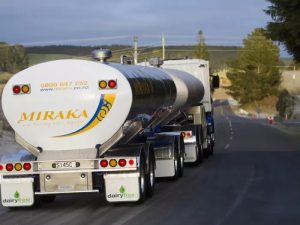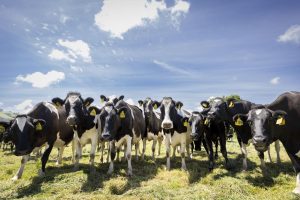
ASB hiked its expectations for Fonterra’s milk price to farmers to the top of the co-operative’s range, saying declining milk production will push payments to a record high this season.
ASB economist Nat Keall lifted his forecast for Fonterra’s farmgate milk price this season by 55 cents to $8.75 per kilogram of milk solids. That’s at the top of Fonterra’s forecast for between $7.25 per kgMS and $8.75 per kgMS, and would surpass the previous record of $8.40 per kgMS paid in the 2013/14 season.
Keall took heart from the latest global dairy trade (GDT) auction which showed whole milk powder, which has the most impact on what farmers are paid, continued to be in demand, with prices for future contracts lifting as production looks set to fall this season.
“GDT events over the first half of spring have shown no sign of demand softening and, with supply continuing to look tight, we’re comfortable making a sizeable upward revision,” Keall said in a note. “A record farmgate milk price for the season is very much live.”
Keall said milk production this season was likely to undershoot previous expectations, and he is expecting New Zealand production to fall by between 0.5 per cent to 1 per cent.
“At the beginning of the season, the general expectation was that higher prices would produce a supply response that would in turn ease future pricing pressures, in line with the usual dairy cycle,” he said.
“That dynamic now looks much less likely – New Zealand milk production has been slow to ramp up as it heads into the peak production months.”
Production was 4 per cent lower in August and probably remained soft in September and October, he said.
Keall said pasture growth has been hampered by weather conditions, and high feed costs and logistics issues could hinder farmers from bringing in extra feed.
He cautioned that an awful lot of uncertainty remained as commodity markets had been volatile so far this year.
ASB’s latest shift comes after it raised its milk price forecast a month ago, to $8.20 per kgMS. Keall said at the time he had been premature in lowering the forecast in July to $7.90 per kgMS following a series of softer auctions where longer dated contracts began to develop a steep downward slope.
Several other analysts have also been hiking their forecasts.
After the previous GDT auction a fortnight ago, Westpac senior agri economist Nathan Penny raised his forecast to $8.50 per kgMS, and ANZ agricultural economist Susan Kilsby raised her forecast to $8.20 per kgMS.
BNZ senior economist Doug Steel last month lifted his milk price forecast to $8.30 per kgMS.
By contrast, Rabobank senior analyst Emma Higgins last month lowered her forecast to $7.80 per kgMS, citing high stock levels in China. Import volumes into China needed to slow or fall to rebalance the market, she said.

The global dairy trade price index increased 2.2 per cent at the fortnightly auction overnight. The average price for whole milk powder lifted 1.5 per cent to US$3803 (NZ$5305) a tonne, which is 25 per cent higher than at the same time last year.
Fonterra has been reducing the amount of whole milk powder it offers on the auction platform, saying it has strong contract demand and expectations for flat milk supply this season will limit its ability to increase production.
Milk production was also soft elsewhere, with weather impacting European production and Chinese and United States production constrained by high feed costs and limited feed availability.
“With strong price gains across each contract period of each commodity, there is now little doubt that buyers are aware of how tight supply is expected to be, and are willing to pay the premium to secure volumes,” said NZX dairy analyst Stuart Davison. “The market doesn’t expect prices to ease from these price points in a hurry.”
Davison said the auction result will be positively received by farmers, as it supports the farmgate milk price.
“The confidence this result has provided will be appreciated, as farmers continue to deal with ongoing challenges on farm, such as labour shortages, cold and wet weather, along with supply chain issues affecting their businesses,” he said.
“However, I still don’t expect a higher farmgate milk price to entice excess milk production, as margins and on farm capabilities remain tight.”
ASB’s Keall said Fonterra had probably already hedged most of its currency exposure at a favourable rate, which would help underpin returns. The co-operative could wind up with an effective exchange rate just north of US69 cents, he said.
























